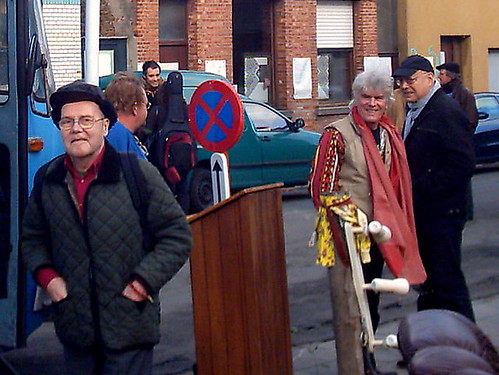Herman J Claeys, Hans Plomp, Rudolph Stokvis @ installation AXIS MUNDI in D☼EL
---------------------------------------------------------
R.I.P. Herman J. Claeys (23.05.1935 - 29.12.2009)
~~~~~~~~~~~~~~~~~~~~~~~~~~~~~~~~
R.I.P. Herman J. Claeys (23.05.1935 - 29.12.2009)
~~~~~~~~~~~~~~~~~~~~~~~~~~~~~~~~
DOEL, a threatened village in Flanders.
In the north of Flanders, near the Holland border, is a small historical village fighting for its survival: it is called Doel, spelled d-o-e-l. It is located on the left bank of the river Scheldt and is now surrounded by the ever expanding harbour of Antwerp.
Although Doel is only a very small village, its skyline is well known throughout Belgium and the Netherlands because it hosts a nuclear power plant with two giant cooling towers with 4 reactors delivering electricity to customers in Belgium, the Netherlands and Germany. With a height of about 170 meters, the two cooling towers are the most visible structure in the Port of Antwerp. In one of my poems on Doel, I call them the Twin Tower Doels.
By the early sixties, the port of Antwerp had outgrown available docklands on the Scheldt's right bank and the Antwerp Port Authority started to build an extensive network of docks, interconnecting channels, and locks at the left bank, to the south of Doel. In the early 1970s, the Port Authority ignored farmers' and villagers' protests and started to expropriate houses in several polder villages, hereby sacrifieing local rural communities to industrial and economic interests.
Because of the port's northbound expansion plans, which also threatened Doel, the authorities proclaimed a "house building freeze", obliging young married couples to leave the village and settle elsewhere for lack of available housing. As a result, the village began to decline. Successful actions by protest groups and local politicians in the late seventies, however, managed to temporarily put a halt to the Port Authority's voracious northbound expansion plans and Doel experienced well over a decade of renewed hope and revival. Thanks to the ferry service, the cosy polder village even became a flourishing tourist attraction.
Yet, its survival dreams were relatively short-lived. As of the mid-nineties, plans for a new dock and two container terminals again tightened the industrial noose around the community's neck. In 1998/99, the Flemish regional government signed the village's death verdict by approving the construction of two new container terminals.
In recent years squatters have come to the village and settled in deserted houses, in defiance of the expropriations company's rental stop. They restored some houses to a habitable status. By now, many of these "newcomers" have positively contributed to the village's viability and social life. Following media reports in 2006 on social tensions, abuses of utilities, and health hazards, the local district authorities decided to regularize the situation of all well-intentioned squatters, to oust troublemakers and to demolish dilapidated houses. Because of these developments, there was again a glimmer of hope…but on 23 March 2007, the Flemish Government decided that Doel will be demolished anyway as of 2009. In June 2008, inhabitants received an official letter notifying them their houses should be evacuated by 1 September 2009.
Despite the efforts by the remaining residents -- both old villagers and newcomers -- to keep the village alive, it has a rather desolate outlook, especially during the winter: streets are empty; schools and shops have been shut down; abandoned houses have been stripped of anything of value and are being used as waste dumps. Rather than yielding these vacant premises to pests and weeds, their possible use as exhibition spaces would prevent further decay and breathe new life into the village.
In the meantime Doel has become an art village with paintings and sculptures inside and outside the abandonned houses, and with poetical and musical events, andfd attracts a lot of visitors from Flanders and nearby Holland.
In February this year, the new village poet Frank Devos extended an invitation to Flemish poets to write a poem for Doel. 70 poets came to Doel on 10 May to write their poems on water-resistant canvases and attach them to the walls of empty houses in Doel. Many poets, including some literary heavyweights, accepted the invitation. One of the main streets in Doel is thus completely "poeticised".
In october, in imitation of Christiania and Ruigoord, an axis mundi was erected by artists from Flanders, Holland and Danmark. This world’s axis in the shape of a totem pole links together the communities of the freeplaces Christiania, Ruigoord and Doel.
Herman J. Claeys, Antwerp nov. 2009
.






No comments:
Post a Comment